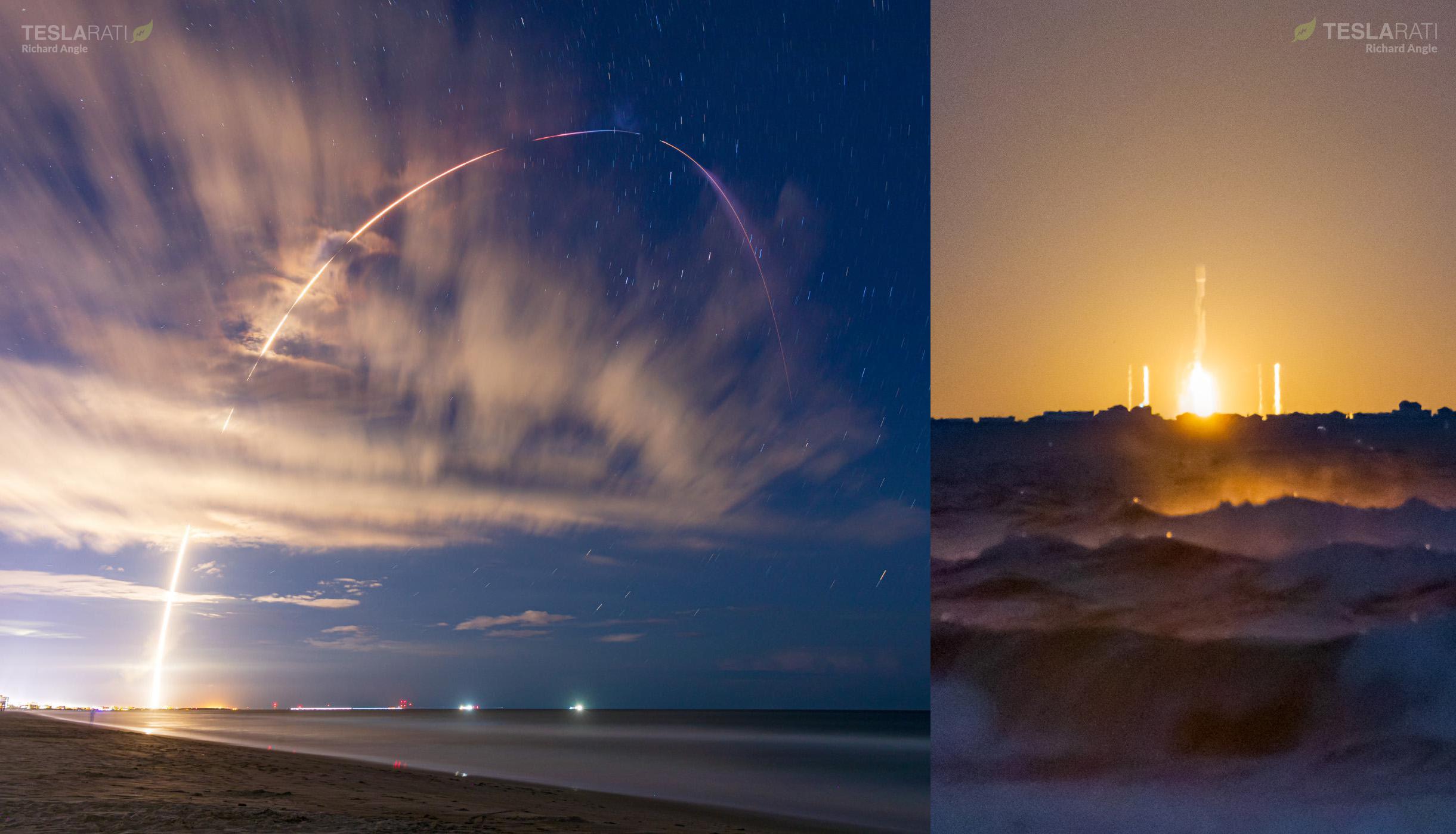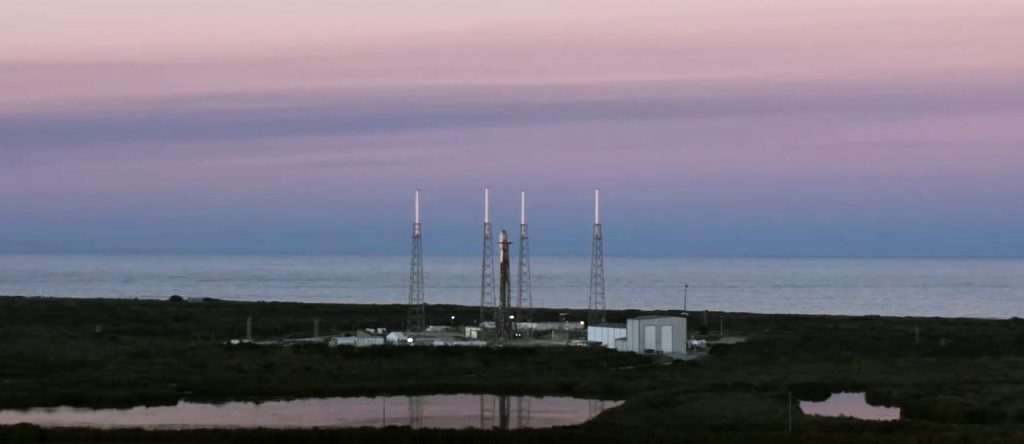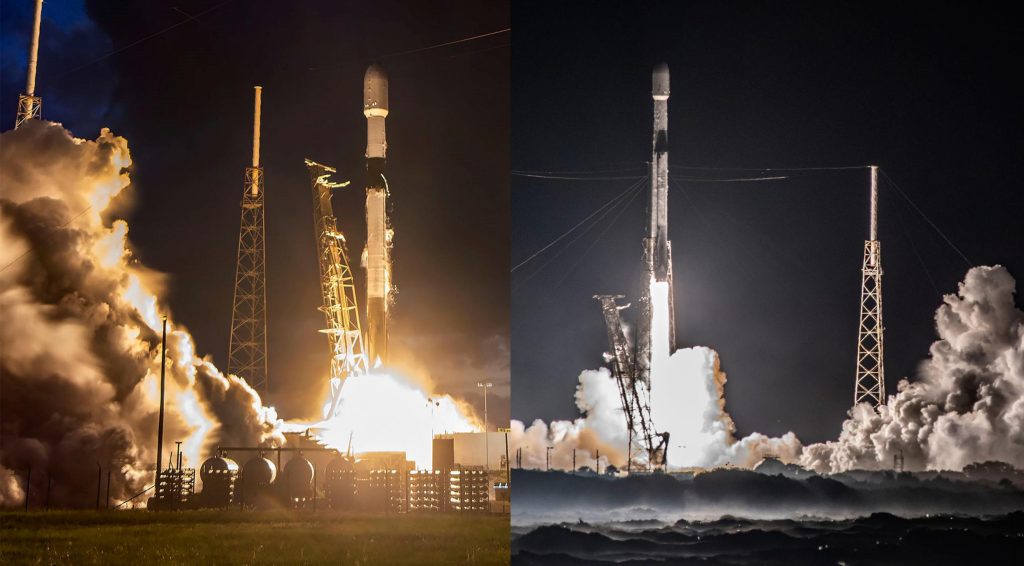

News
SpaceX breaks pad turnaround record with two Falcon 9 launches in six days
SpaceX has completed its 43rd launch of 2022 and 62nd dedicated Starlink launch overall, breaking a launch pad turnaround record in the process.
That pad – Cape Canaveral Space Force Station (CCSFS) Launch Complex 40 (LC-40) – is the single most important cog in SpaceX’s Falcon 9 launch machine, significantly increasing the significance of what might otherwise be ‘just’ another broken record for a company that is famous for never settling.
Following several delays linked to another weather-plagued Starlink launch (4-34) that flew out of the same pad, a Falcon 9 rocket lifted off from LC-40 on SpaceX’s Starlink 4-35 mission at 7:32 pm EDT (23:32 UTC), Saturday, September 24th. As usual, the mission used a flight-proven Falcon 9 booster (B1073), two flight-proven payload fairing halves, and an expendable second stage. As usual, all four components performed flawlessly, and a new batch of 52 Starlink V1.5 satellites was deployed about 15 minutes after liftoff.
Just the latest of dozens completed since May 2019, SpaceX’s Starlink missions have become extraordinarily routine – a testament to the company’s relentless pursuit of perfection, given just how difficult it is to successfully launch a rocket once. 62 dedicated Starlink launches later, Falcon 9 has successfully delivered every single Starlink satellite it has ever carried (almost 3400 spacecraft) into the proper orbit, losing only two boosters in the process.
But even though the missions have become routine, SpaceX has spent every waking second optimizing its rockets and operations to squeeze more performance and more cadence out of each part. The results can only be described as a resounding success. In 2018 and 2019, SpaceX launched an average of 17 Falcon rockets per year. SpaceX’s annual cadence grew to 26 launches in 2020 and 31 in 2021.
That progress pales next to the cadence SpaceX is on track to achieve in 2022. In less than nine months, the company has completed 43 Falcon 9 launches. Before the end of July, barely six months into the year, SpaceX had beaten its annual record of 31 launches. If it can maintain the same average pace it’s sustained over the last 12 months, SpaceX could realistically complete 58 Falcon launches in 2022. If it continues the even more impressive pace it’s achieved in Q3 (~17 launches), it could manage 60+ launches this year.
Only one other rocket family in history (the Soviet R-7) has successfully completed more launches in a calendar year.
SpaceX, of course, has no plans to accept the potentially record-breaking launch cadence it’s achieved as a new status quo. Just two-thirds of the way through 2022, CEO Elon Musk revealed that SpaceX is targeting up to 100 launches in 2023. As previously reported on Teslarati, while that figure seems implausible at first glance, it was still within the realm of possibility given SpaceX’s already established capabilities.
Just a few weeks later, Musk’s 100-launch target has gone from barely within reach to a serious – if still unlikely – possibility thanks to the record SpaceX broke with Starlink 4-35. SpaceX’s latest Starlink mission lifted off from LC-40 just 5.97 days after Starlink 4-34 launched from the same pad, smashing its old turnaround record (7.67 days) by almost 25%.
For LC-40, already SpaceX’s workhorse pad and the source of the company’s fastest pad turnaround, the new record means, in theory, that one of its three pads can now singlehandedly support up to 60 Falcon 9 launches per year. Assuming that any launch pad can or will sustainably operate close to its record turnaround time for an entire year would be unwise. But, at minimum, the new record gives SpaceX new margins that it can use to significantly increase LC-40’s annual cadence in a more sustainable way. In 2022, LC-40 has averaged 12.7 days per launch. In Q3, it’s on track to average about 10.3 days per launch.


Most importantly, there’s evidence that SpaceX didn’t simply manage a heroic one-time feat with Starlink 4-35. Confirmed by Next Spaceflight, Ben Cooper, and airspace restriction filings, SpaceX has tentative plans to launch Starlink 4-36 from LC-40 as early as 6:36 pm EDT on Friday, September 30th – a turnaround slightly faster than the new record. Another Falcon 9 launch out of LC-40 – EchoStar’s Galaxy 33/34 mission – could follow Starlink 4-36 as early as October 5th, although that mission is more likely to slip a day or two.
There’s a big risk that Storm/Hurricane Ian will create unacceptable weather conditions, forcing SpaceX to delay the launch, but for now, there’s still a chance.
Elon Musk
Tesla investors will be shocked by Jim Cramer’s latest assessment
Jim Cramer is now speaking positively about Tesla, especially in terms of its Robotaxi performance and its perception as a company.

Tesla investors will be shocked by analyst Jim Cramer’s latest assessment of the company.
When it comes to Tesla analysts, many of them are consistent. The bulls usually stay the bulls, and the bears usually stay the bears. The notable analysts on each side are Dan Ives and Adam Jonas for the bulls, and Gordon Johnson for the bears.
Jim Cramer is one analyst who does not necessarily fit this mold. Cramer, who hosts CNBC’s Mad Money, has switched his opinion on Tesla stock (NASDAQ: TSLA) many times.
He has been bullish, like he was when he said the stock was a “sleeping giant” two years ago, and he has been bearish, like he was when he said there was “nothing magnificent” about the company just a few months ago.
Now, he is back to being a bull.
Cramer’s comments were related to two key points: how NVIDIA CEO Jensen Huang describes Tesla after working closely with the Company through their transactions, and how it is not a car company, as well as the recent launch of the Robotaxi fleet.
Jensen Huang’s Tesla Narrative
Cramer says that the narrative on quarterly and annual deliveries is overblown, and those who continue to worry about Tesla’s performance on that metric are misled.
“It’s not a car company,” he said.
He went on to say that people like Huang speak highly of Tesla, and that should be enough to deter any true skepticism:
“I believe what Musk says cause Musk is working with Jensen and Jensen’s telling me what’s happening on the other side is pretty amazing.”
Tesla self-driving development gets huge compliment from NVIDIA CEO
Robotaxi Launch
Many media outlets are being extremely negative regarding the early rollout of Tesla’s Robotaxi platform in Austin, Texas.
There have been a handful of small issues, but nothing significant. Cramer says that humans make mistakes in vehicles too, yet, when Tesla’s test phase of the Robotaxi does it, it’s front page news and needs to be magnified.
He said:
“Look, I mean, drivers make mistakes all the time. Why should we hold Tesla to a standard where there can be no mistakes?”
It’s refreshing to hear Cramer speak logically about the Robotaxi fleet, as Tesla has taken every measure to ensure there are no mishaps. There are safety monitors in the passenger seat, and the area of travel is limited, confined to a small number of people.
Tesla is still improving and hopes to remove teleoperators and safety monitors slowly, as CEO Elon Musk said more freedom could be granted within one or two months.
News
Tesla launches ultra-fast V4 Superchargers in China for the first time
Tesla has V4 Superchargers rolling out in China for the first time.

Tesla already has nearly 12,000 Supercharger piles across mainland China. However, the company just initiated the rollout of the ultra-fast V4 Superchargers in China for the first time, bringing its quick-charging piles to the country for the first time since their launch last year.
The first batch of V4 Superchargers is now officially up and running in China, the company announced in a post on Chinese social media outlet Weibo today.
The company said in the post:
“The first batch of Tesla V4 Superchargers are online. Covering more service areas, high-speed charging is more convenient, and six-layer powerful protection such as rain and waterproof makes charging very safe. Simultaneously open to non-Tesla vehicles, and other brands of vehicles can also be charged. There are more than 70,000 Tesla Superchargers worldwide. The charging network layout covers 100% of the provincial capitals and municipalities in mainland China. More V4 Superchargers will be put into use across the country. Optimize the charging experience and improve energy replenishment efficiency. Tesla will accompany you to the mountains, rivers, lakes, and seas with pure electricity!”
The first V4 Superchargers Tesla installed in China are available in four cities across the country: Shanghai, Zhejiang, Gansu, and Chongqing.

Credit: Tesla China
Tesla has over 70,000 Superchargers worldwide. It is the most expansive and robust EV charging network in the world. It’s the main reason why so many companies have chosen to adopt Tesla’s charging connector in North America and Europe.
In China, some EVs can use Tesla Superchargers as well.
The V4 Supercharger is capable of charging vehicles at speeds of up to 325kW for vehicles in North America. This equates to over 1,000 miles per hour of charging.
Elon Musk
Elon Musk hints at when Tesla could reduce Safety Monitors from Robotaxi
Tesla could be reducing Safety Monitors from Robotaxi within ‘a month or two,’ CEO Elon Musk says.

Elon Musk hinted at when Tesla could begin reducing Safety Monitors from its Robotaxis. Safety Monitors are Tesla employees who sit in the front passenger seat during the driverless rides, and are there to ensure safety for occupants during the earliest rides.
Tesla launched its Robotaxi fleet in Austin last Sunday, and after eight days, videos and reviews from those who have ridden in the driverless vehicles have shown that the suite is safe, accurate, and well coordinated. However, there have been a few hiccups, but nothing that has put anyone’s safety in danger.
A vast majority — close to all of the rides — at least according to those who have ridden in the Robotaxi, have been performed without any real need for human intervention. We reported on what was the first intervention last week, as a Safety Monitor had to step in and stop the vehicle in a strange interaction with a UPS truck.
Watch the first true Tesla Robotaxi intervention by safety monitor
The Tesla and UPS delivery truck were going for the same street parking space, and the Tesla began to turn into it. The UPS driver parallel parked into the spot, which was much smaller than his truck. It seemed to be more of an instance of human error instead of the Robotaxi making the wrong move. This is something that the driverless cars will have to deal with because humans are aggressive and sometimes make moves they should not.
The Safety Monitors have not been too active in the vehicles. After all, we’ve only seen that single instance of an intervention. There was also an issue with the sun, when the Tesla braked abnormally due to the glare, but this was an instance where the car handled the scenario and proceeded normally.
With the Robotaxi fleet operating impressively, some are wondering when Tesla will begin scaling back both the Safety Monitors and Teleoperators that it is using to ensure safety with these early rides.
CEO Elon Musk answered the inquiry by stating, “As soon as we feel it is safe to do so. Probably within a month or two.”
As soon as we feel it is safe to do so.
Probably within a month or two. We continue to improve the Tesla AI with each mile driven.
— Elon Musk (@elonmusk) June 30, 2025
Musk’s response seems to confirm that there will be fewer Teleoperators and Safety Monitors in the coming months, but there will still be some within the fleet to ensure safety. Eventually, that number will get to zero.
Reaching a point where Tesla’s Robotaxi is driverless will be another significant milestone for the company and its path to fully autonomous ride-sharing.
Eventually, Tesla will roll out these capabilities to consumer-owned vehicles, offering them a path to generate revenue as their car operates autonomously and completes rides.
For now, Tesla is focusing on perfecting the area of Austin where it is currently offering driverless rides for just $4.20 to a small group of people.
-

 News5 days ago
News5 days agoTesla Robotaxi’s biggest challenge seems to be this one thing
-

 News2 weeks ago
News2 weeks agoTesla confirms massive hardware change for autonomy improvement
-

 Elon Musk2 weeks ago
Elon Musk2 weeks agoElon Musk slams Bloomberg’s shocking xAI cash burn claims
-

 News2 weeks ago
News2 weeks agoTesla China roars back with highest vehicle registrations this Q2 so far
-

 News2 weeks ago
News2 weeks agoTesla features used to flunk 16-year-old’s driver license test
-

 News2 weeks ago
News2 weeks agoTexas lawmakers urge Tesla to delay Austin robotaxi launch to September
-

 News2 weeks ago
News2 weeks agoTesla dominates Cars.com’s Made in America Index with clean sweep
-

 News2 weeks ago
News2 weeks agoTesla’s Grok integration will be more realistic with this cool feature





















